Reed Berkowitz creates award-winning educational, gaming, and entertainment products for the US and international markets. He got his start in game designing by creating educational games with popular children's properties including Peanuts, Sanrio (Hello Kitty) and Felix the Cat.
A Game Designer’s Analysis Of QAnon
Playing with reality
Courtesy of Reed Berkowitz, Curiouserinstitute, @curiouser llc

© 2019 Marc Nozell — QAnon in red shirt — (CC BY 2.0)
I am a game designer with experience in a very small niche. I create and research games designed to be played in reality. I’ve worked in Alternate Reality Games (ARGs), LARPs, experience fiction, interactive theater, and “serious games”. Stories and games that can start on a computer, and finish in the real world. Fictions designed to feel as real as possible. Games that teach you. Puzzles that come to life all around the players. Games where the deeper you dig, the more you find. Games with rabbit holes that invite you into wonderland and entice you through the looking glass.
When I saw QAnon, I knew exactly what it was and what it was doing. I had seen it before. I had almost built it before. It was gaming’s evil twin. A game that plays people. (Cue ominous music.)
QAnon has often been compared to ARGs and LARPs and rightly so. It uses many of the same gaming mechanisms and rewards. It has a game-like feel to it that is evident to anyone who has ever played an ARG, online role-play (RP) or LARP before. The similarities are so striking that it has often been referred to as a LARP or ARG. However this beast is very very different from a game.
It is the differences that shed the light on how QAnon works and many of them are hard to see if you’re not involved in game development. QAnon is like the reflection of a game in a mirror, it looks just like one, but it is inverted.
Guided Apophenia
In one of the very first experience fictions (XF) I ever designed, the players had to explore a creepy basement looking for clues. The object they were looking for was barely hidden and the clue was easy. It was Scooby Doo easy. I definitely expected no trouble in this part of the game.

©Art Jonak 2012 — Coolest cloud ever! — CC BY-NC 2.0
But there was trouble. I didn’t know it then, but its name was APOPHENIA.
Apophenia is : “the tendency to perceive a connection or meaningful pattern between unrelated or random things (such as objects or ideas)”
As the participants started searching for the hidden object, on the dirt floor, were little random scraps of wood.
How could that be a problem!?
It was a problem because three of the pieces made the shape of a perfect arrow pointing right at a blank wall. It was uncanny. It had to be a clue. The investigators stopped and stared at the wall and were determined to figure out what the clue meant and they were not going one step further until they did. The whole game was derailed. Then, it got worse. Since there obviously was no clue there, the group decided the clue they were looking for was IN the wall. The collection of ordinary tools they found conveniently laying around seemed to enforce their conclusion that this was the correct direction. The arrow was pointing to the clue and the tools were how they would get to it. How obvious could it be?
I stared in horror because it all fit so well. It was better and more obvious than the clue I had hidden. I could see it. It was all random chance but I could see the connections that had been made were all completely logical. I had a crude backup plan and I used it quickly before these well-meaning players started tearing apart the basement wall with crowbars looking for clues that did not exist.
These were normal people and their assumptions were normal and logical and completely wrong.
In most ARG-like games apophenia is the plague of designers and players, sometimes leading participants to wander further and further away from the plot and causing designers to scramble to get them back or (better yet) incorporate their ideas. In role-playing games, ARGs, video games, and really anything where the players have agency, apophenia is going to be an issue.
This happens because in real games there are actual solutions to actual puzzles and a real plot created by the designers. It’s easy to get off track because there is a track. A great game runner (often called a puppet-master) can use one or two of these speculations to create an even better game, but only as much as the plot can be adjusted for in real time or planned out before-hand. It can create amazing moments in a game, but it’s not easy. For instance, I wish I could have instantly entombed something into that wall in the basement because it would have worked so well, but I was out of luck!
If you are a designer, and have puzzles, and have a plot, then apophenia is a wild card you always have to be concerned about.
QAnon is a mirror reflection of this dynamic. Here apophenia is the point of everything. There are no scripted plots. There are no puzzles to solve created by game designers. There are no solutions.
QAnon grows on the wild misinterpretation of random data, presented in a suggestive fashion in a milieu designed to help the users come to the intended misunderstanding. Maybe “guided apophenia” is a better phrase. Guided because the puppet masters are directly involved in hinting about the desired conclusions. They have pre-seeded the conclusions. They are constantly getting the player lost by pointing out unrelated random events and creating a meaning for them that fits the propaganda message Q is delivering.
There is no reality here. No actual solution in the real world. Instead, this is a breadcrumb trail AWAY from reality. Away from actual solutions and towards a dangerous psychological rush. It works very well because when you “figure it out yourself” you own it. You experience the thrill of discovery, the excitement of the rabbit hole, the acceptance of a community that loves and respects you. Because you were convinced to “connect the dots yourself” you can see the absolute logic of it. This is the conclusion you arrived at. More about this later.
Everyone on the board agrees with you because it’s highly likely they were the ones that pointed it out to you just for that purpose. (More on this later.)
“Hey, what’s that?!”
“It looks like an arrow, pointing at the wall.”
“Why do you think it’s there? Do people just leave arrows pointing to things randomly? What does your common sense say about that?”
“It says there must be something there.”
“Yes. You are right. Maybe you should look at it more closely?”
Every cloud has a shape that can look like something else. Everything that flickers is also a jumble of Morse code. The more information that is out there, the easier it is to allow apophenia to guide us into anything. This is about looking up at the sky and someone pointing out constellations.
The difference is that these manufactured connections lead to the desired conclusions Q’s handlers have created. When players arrive at the “correct” answers they are showered with adoration, respect, and social credit. Like a teenage RP, the “correct” answer is the one that the group respects the most and makes the story the most enjoyable. The idea that bolsters the theory. The correct answer is the one that provides the poster with the most credit.
It’s like a Darwinian fiction lab, where the best stories and the most engaging and satisfying misinterpretations rise to the top and are then elaborated upon for the next version.
Even Q-Anon was only one of several “anons” including FBIanon and CIAanon, etc, etc. Q rose to the top, so it got its own YouTube channels. That tested, so it moved to Reddit. The theories that didn’t work, disappeared while others got up-voted. It’s ingenious. It’s AI with a group-think engine. The group, led by the puppet masters, decide what is the most entertaining and gripping explanation, and that is amplified. It’s a Slenderman board gone amok.
Let’s go back to the arrow on the ground again.
It was not an arrow on the ground, pointing to a clue in a wall. It was just some random bits of wood. They did not discover an arrow. They created it. They saw random pieces of wood and applied their intelligence to it, and this is everything.
It’s easy for people to forget that they are not discovering the story, but creating it from random data.
Propaganda and Manipulation
Another major difference between QAnon and an actual game, is that Q is almost pure propaganda. That IS the sole purpose of this. It’s not advertising a product, it’s not for fun, and it’s not an art project. There is no doubt about the political nature of the propaganda either. From ancient tropes about Jews and Democrats eating babies (blood-libel re-booted) to anti-science hysteria, this is all the solid reliable stuff of authoritarianism. This is the internet’s re-purposing of hatred’s oldest hits. The messaging is spot on. The “drops” implanted in an aspic of anti-Semitic, misogynist, and grotesque posts on posting boards that, indeed, have been implicated in many of the things the fake conspiracy is supposed to be guilty of!
Q is also operating in conjunction with many other initiatives as documented by other sources and other developers. The coordination is consistent.
A game helps the people who play build an internal world that best serves them. Q helps players develop an internal world that best serves Q’s initiatives.
Let’s look at how that works.
Game Play
Q is a fictional character
I’m afraid this needs to be said. Q is not a real person, but a fictional character.
QAnon uses the oldest trope of all mystery fiction. A mysterious stranger shows up and drops a strange clue leading to long-hidden secrets which his clues, and your detecting power, can reveal.
Let’s think about this for a minute. How many great movies, books, and TV shows would have been forever ruined if the mysterious stranger just laid it all out for the protagonists in the first meeting. “Jim did it. It’s Jim. He’s laundering money for the mob. Check his bank records. Never mind, I have them right here.” The X-Files would be a lot shorter if The Smoking Man had just used his words.

William B. Davis as the Cigarette Smoking Man in The X-Files Copyright Fox Broadcasting Company
It doesn’t work that way. The fictional mysterious stranger already knows, but instead of telling you the answer in the first ten minutes, they give you clues. Hard to follow clues. Ambiguous clues. They say things like “Follow the money. Don’t let them fool you. This goes all the way to the top.”
There is no reason for this in reality, but fictionally, this is what creates the whole plot, the sense of mystery, and everything entertaining that is to follow. This is the white rabbit. This is the breadcrumb trail out of the forest.
It doesn’t work for reality. Real people in the government with important information to disseminate deliver it as fast as possible usually all in one go. They don’t make you solve things. They try to be as specific as possible. They are whistle blowers. Daniel Ellsberg (the Pentagon Papers). Edward Snowden. Chelsea Manning. Etc.
Q is NOT a whistleblower. Q is a “plot device”. Q is fictional and acts exactly like a fictional character acts. This is because the purpose of Q is not to divulge actual information, but to create fiction.
dO tHe ReSeaRcH
The fictional reason Q doesn’t just tell the world what they know is that Q wants you to “do your own research” and come to your own conclusions. How polite…
This is not a real reason. Q does not want you to come to your own conclusions. Q is feeding you conclusions. This is VERY important and here are several reasons why this is included in the verbiage of almost every fictional conspiracy theory ever.
1: Follow The Breadcrumbs
Telling people how and what they should think is the path of most resistance. Ideas that challenge us can do just the opposite of convincing us or enlightening us, but further engrain our old ideas. Even when presented with factual evidence.
“It is well known that people often resist changing their beliefs when directly challenged, especially when these beliefs are central to their identity 1,2,3,4,5,6. In some cases, exposure to counterevidence may even increase a person’s confidence that his or her cherished beliefs are true 7,8.”
https://www.nature.com/articles/srep39589
Strongly held beliefs are literally a part of us. As such, attacks on core beliefs are treated very much as attacks on us, even as strongly as a physical attack.
“The brain’s primary responsibility is to take care of the body, to protect the body,” Jonas Kaplan, a psychologist at the University of Southern California, tells me. “The psychological self is the brain’s extension of that. When our self feels attacked, our [brain is] going to bring to bear the same defenses that it has for protecting the body.”
Why we react to inconvenient truths as if they were personal insults, by Brian Resnick
If the ideas are generated by us, however, then these are the ideas we defend. If we “create” the ideas in our own minds, they become fused much more intently into our personality. They’re OURS. There is no friction. Guiding people to arrive at YOUR conclusions is a perfect way to get people to accept a new and conflicting ideology.
Getting them to arrive at the destination can be a little tricky. You have to guide them there one little step at a time.
In QAnon parlance, these steps, or trail markers leading you into the forest, are called breadcrumbs. Little morsels Q disperses that are easy to digest that lead the players towards wherever Q is guiding them. One little bite at a time.
But the breadcrumbs are not facts, they are questions. Puzzles and clues for the “investigators” to uncover.
This leads us to another reason Q would really like you to do your own research.
2: The Eureka Effect
Puzzle-solving is a special way to learn and it encodes information into the brain in a different way than other learning. Puzzles and knowledge gained through our own efforts are incredibly rewarding and also come with a hit of dopamine, the brain’s pleasure drug, as a reward.
As far back as 1978, it has been known that having an “Aha!” moment increases retention of memories.
Recently, a report published in 2018 in the journal Human Brain Mapping found that Aha! moments also activate the brain’s reward systems.
Aha!-moments are characterized by hyperactivation in (a) nucleus accumbens, which has been shown to be involved in the feeling of relief, ease, and joy, (b) VTA, which is related to the encoding of certainty about a decision, (c) the posterior hippocampus, responsible for memory reorganization following an insight, and (d) aSTS/STG associated coarse semantic coding.
[…]
As those structures are part of a dopaminergic pathway, associated with reinforcement, we suggest the Aha!-Moment as a special form of fast retrieval, combination, and encoding process.
https://onlinelibrary.wiley.com/doi/pdfdirect/10.1002/hbm.24073
Basically, that “A Ha!” moment when puzzle solving (even when incorrect) is extremely pleasurable and also may help encode what we learn in a new way.
It also helps reinforce the desire to seek out and solve new puzzles.
In other words, solving puzzles is extremely rewarding from a biochemical standpoint and the thoughts we gain from them are special to us.
3. Lamestream Media
Another extremely important “reason” for propagandists to get people to “do the research” is to instill a natural distrust for society and the competency of others.
There is no need for QAnons to do the research because the fact is, the research has already been done and been done by thousands of trained professionals. The FBI, CIA, and countless non-profits dedicated to solving the issues of trafficking and abuse have already been working on these issues for decades. If anons really wanted to do the research they should research getting a license in social work, psychology, criminal justice, or really anything that might actually be considered research.
Do your own research means. “Don’t trust other people. Don’t trust institutions. Listen to me.”
The conspiracy plot always has the same logic. The reason no one knows about the conspiracy is because of the conspiracy. Not because it doesn’t exist.
Then initiates are given the tools to arrive at “their own conclusions” which are in every way more compelling, interesting, and solve more problems than traditional conclusions. Because they are wrong and fictional.
4: Community
Solving puzzles together is a great way to form community and to join community. ARGs are famous for this. Everyone has something to focus on, a shared interest, and something to do. The puzzles are often just a way of getting together. If Q drops some clues, then you have something to do and you have people to do it with. It’s bonding. The same reason puzzles are used in corporate team building exercises and party games.
Especially if those people are there with the intent to make you feel and think something specific. To befriend you and make you feel special. Working together on something is a great way for that to happen.
Gameplay Example:
Several Q drops insinuate that the ruling class of occultists have the mandate to tell each other who they are through symbolism. A requirement even.
This is a way of creating a rich set of random data that can be linked together by group-think to support the main theory. It’s simple, compelling, and there is plenty of precedent to this idea too. Everyone “knows” that there are symbols associated with magic, occult, and closed societies. Like the mason compass and the pentagram. One of the groups that love to use symbols to alert others they are a member is actually QAnon so the practice is familiar.
Here are a couple of “drops” in a similar vein.
Their need for symbolism will be their downfall.
Follow the Owl & Y head around the world.
Identify and list.
They don’t hide it.
They don’t fear you.
You are sheep to them.
You are feeders.
Godfather III.
Q
Here is another example.
Identify symbolism (Owl / Y).
Which performers/celebs supported HRC during the election?
Who performed during her rallies?
What jewelry and/or tattoos present?
What other events do they attend together?
What does HRC represent to them?
What celebrities have owl / Y head symbols?
What politicians have owl / Y head symbols?
What powerful people have owl / Y head symbols?
What powerful groups have owl / Y head symbols?
Why are they worn/shown openly?
Their need for symbolism will be their downfall.
Each breadcrumb amounts to a creative writing prompt. A conspiracy connect the dots.
It gives players a doable task they can all collaborate on.
Is this real? Are Hollywood celebrities and political figures really making occult signs like owls and yacks? “Investigators” head out to Google to find out. Here is what they come back with.
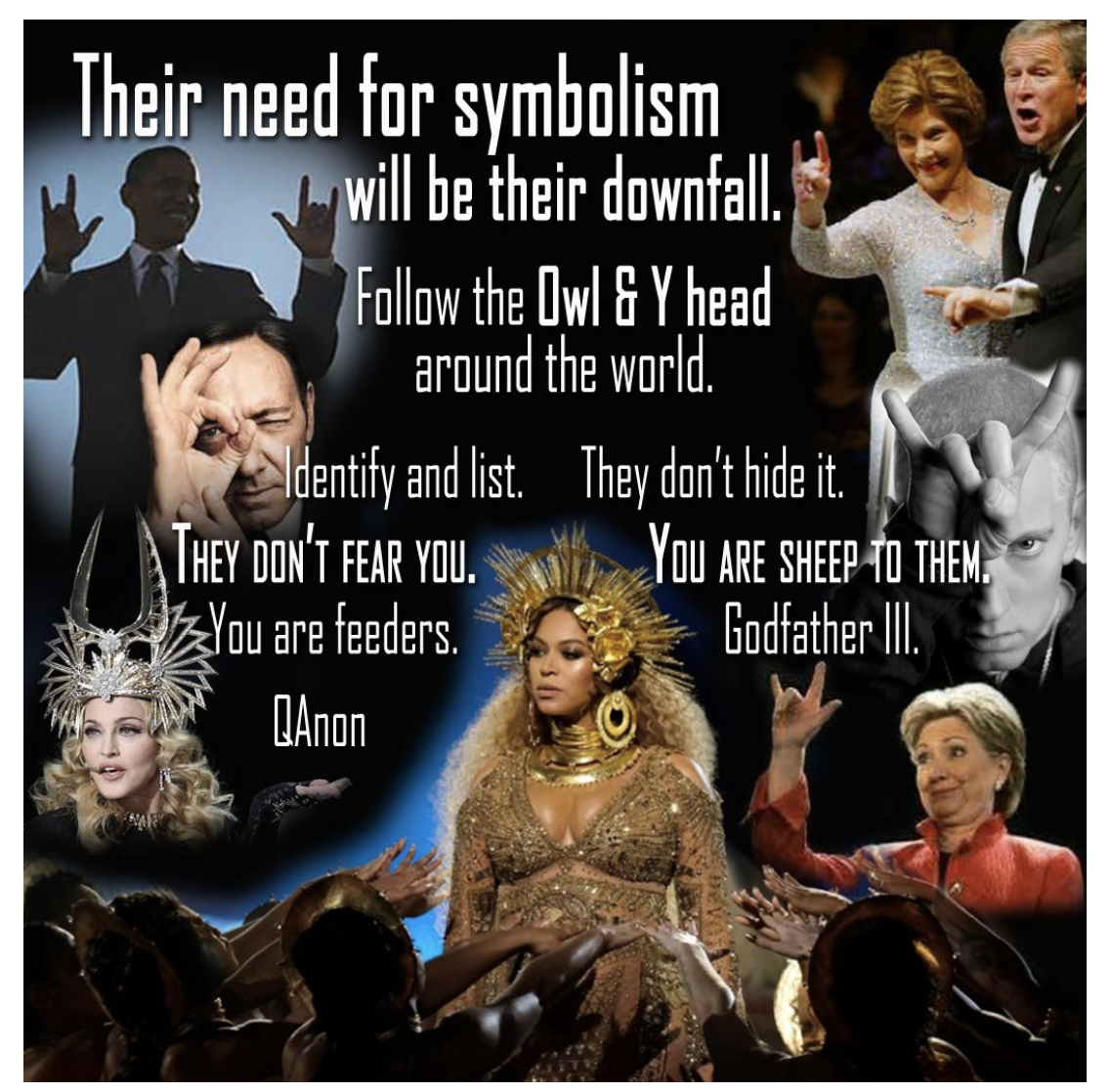
(Beyoncé is rumored in previous conspiracy theories to be the head of the Illuminati.)
Qanon went digging and found hundreds of images. Maybe you didn’t see it before, but now you can’t STOP seeing it.
This isn’t the first or the last symbolism meme either. Some QAnon, some pre-dating Q. They certainly aren’t hard to find once you start “researching”.
Here is the “666 symbol.
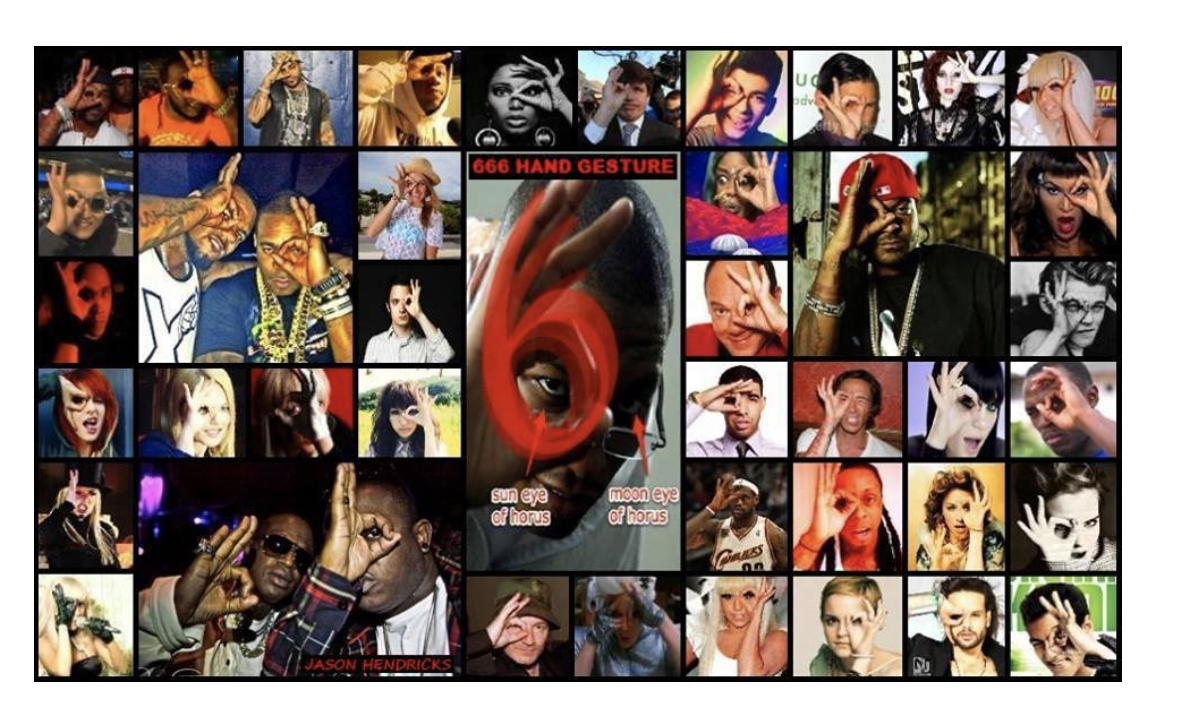
Here is the Illuminati “one eye” “eye of providence” symbol, like the one on the pyramid.
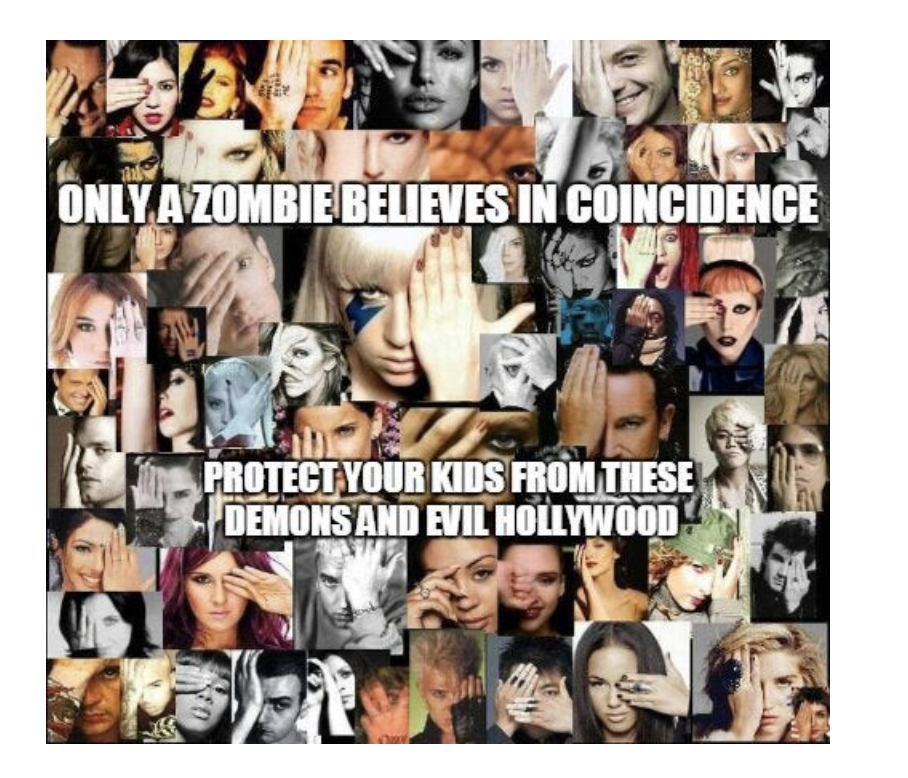
Now, like in traditional ARGs, participants get to look at the world a little differently. They can go on the boards, watch the videos, ask questions. They can submit their own “research” and get kudos, encouraging comments, and make friends. They don’t have to believe it all, but now when they see a new music video, maybe they begin to notice just how many weird things are in them? Could it be that they aren’t just filler, but have a real meaning?
From Fiction to Reality
Already, the game mechanics have begun to turn on the participant.
 The participant is having fun looking around and “solving” riddles reinforced by dopamine rushes and the feeling of being involved in something that no one else knows. They are also now part of a growing, active, and friendly community. Everything they see and hear creates further doubt about people and things they already doubt. Every new theory is easy to understand, compelling, and arrived at through their own ability to reason. Now to doubt certain ideas is to doubt themselves, their ability to see the truth, their community, and maybe the world around them. Quickly, the game is creating an alternate POV that is immensely psychologically satisfying and seems to be supported on all sides as the truth. Celebrities, senators, and even the President are all supportive.
The participant is having fun looking around and “solving” riddles reinforced by dopamine rushes and the feeling of being involved in something that no one else knows. They are also now part of a growing, active, and friendly community. Everything they see and hear creates further doubt about people and things they already doubt. Every new theory is easy to understand, compelling, and arrived at through their own ability to reason. Now to doubt certain ideas is to doubt themselves, their ability to see the truth, their community, and maybe the world around them. Quickly, the game is creating an alternate POV that is immensely psychologically satisfying and seems to be supported on all sides as the truth. Celebrities, senators, and even the President are all supportive.
The implications in the Q prompts are one-sided and designed to cast doubt, not offer proof. Once doubt is cast, it is incredibly hard to dispel.
It’s very hard to prove something doesn’t exist. You can’t prove there are no aliens for example. Aliens scientifically could exist so you will never be able to prove that they don’t. You can’t prove someone isn’t in a cult either. No matter what they say. Doubt can not be dispelled easily. It can be grown easily, however.
Every creepy picture of a celebrity making devil horns or dressed up in a bloody gown.
Imagine the participants looking through hundreds of images of the people they distrust acting completely like they are in a cult.
Rock stars are always trying to shock people. They throw the hand-horns all the time. Their videos are riddled with the skulls of steers and weird tattoos and conscious occult references.
“I don’t know if I believe it, but it IS weird, right? It does kind of look like they are in a cult. I don’t wear a goat’s head! Why would anyone do that? Could some of them be rich freaks? I’ve heard so much about the Rothschilds…”
Then the idea gets force-multiplied in thousands of sites, YouTube videos, ads, comments, Instagram influencers, tweets, etc. It’s everywhere, and every place you go (in your bubble), keeps telling you it is true. Even places you go outside your bubble tell you it’s true (because that’s how ads work).
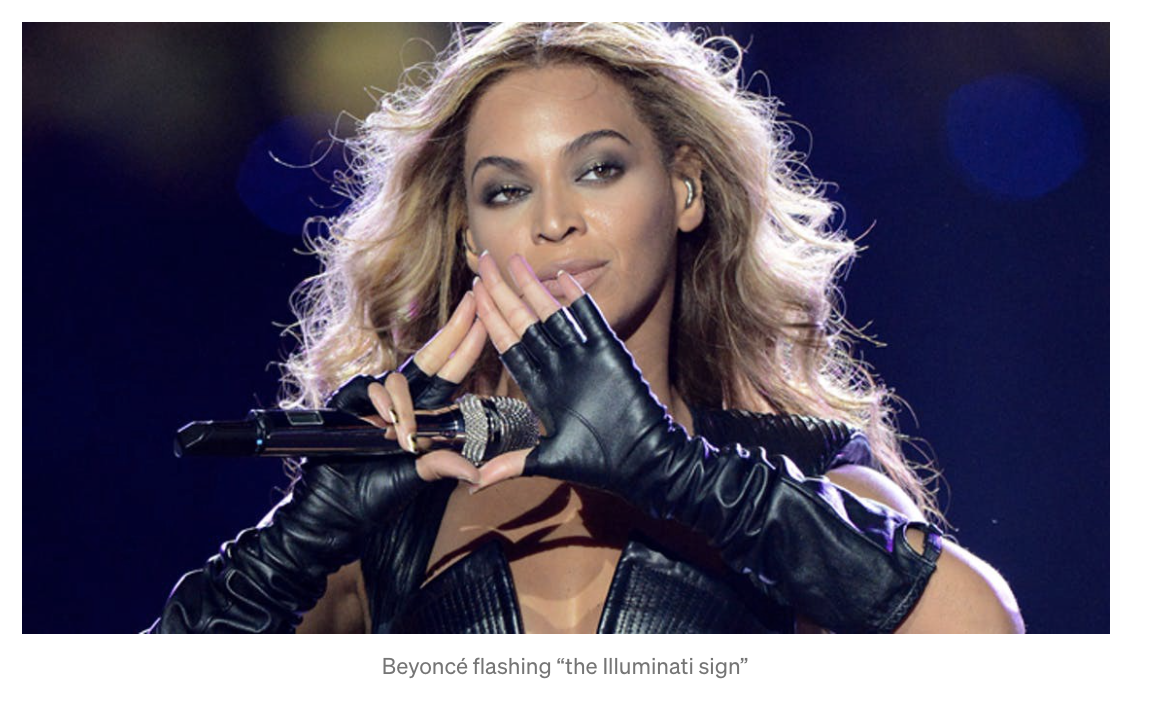
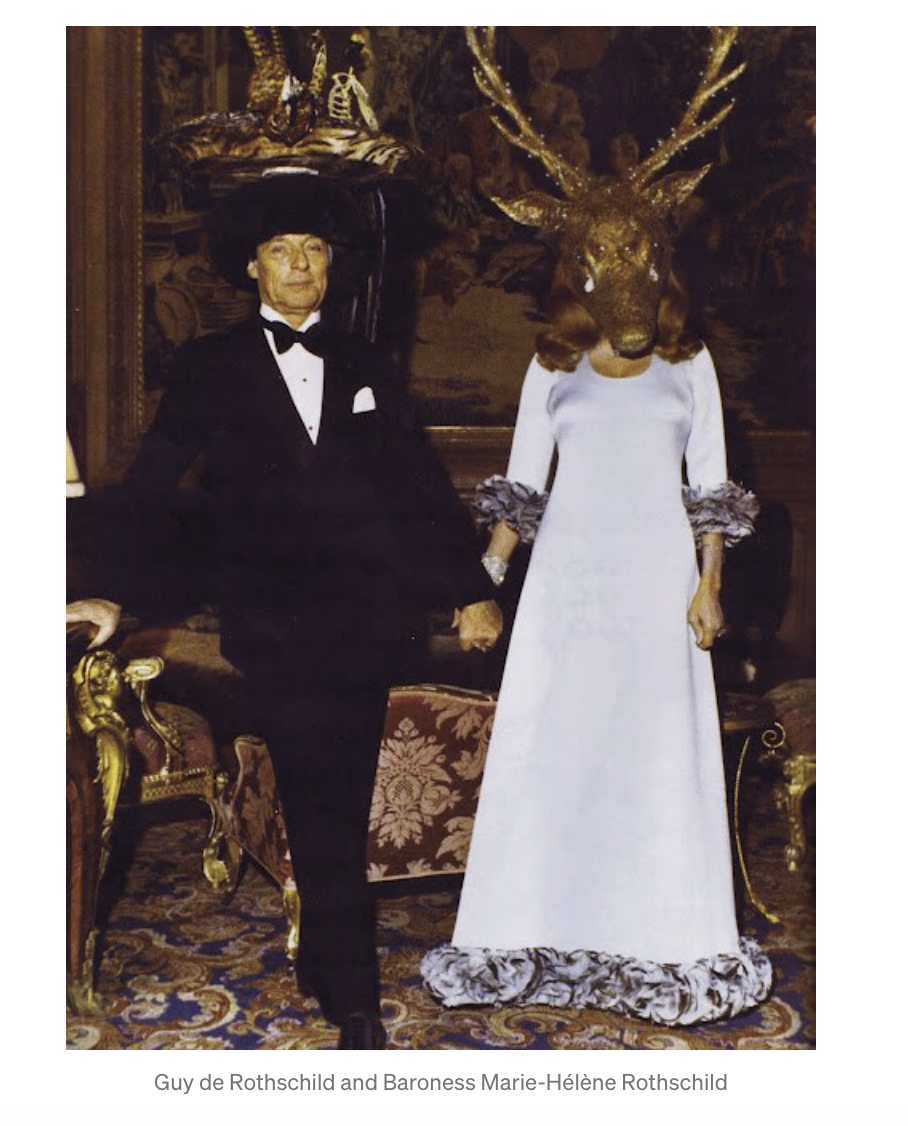 People might dig up all the articles about Beyoncé being the head of the Illuminati along with Jay-Z flashing the Illuminati sign. And then you learn that Jay-Z actually IS interested in the Illuminati and has been flashing the sign for six years.
People might dig up all the articles about Beyoncé being the head of the Illuminati along with Jay-Z flashing the Illuminati sign. And then you learn that Jay-Z actually IS interested in the Illuminati and has been flashing the sign for six years.
I mean, it can’t be true, can it?
And then there are the sad facts. There are abusers in Hollywood. Rich, weird, Hollywood Jews too. Harvey Weinstein. Epstein. Why not the Rothschilds? Can you get the image out of your head of that creepy old rich guy and his wife wearing a devil head?
The doubt grows every day.
Until it isn’t doubt.
Until you’re “pretty sure”.
Of course, Q knows these images of the Rothschilds are out there and knows they are out of context (a surrealist costume ball). Same with the abundance of occult imagery in modern music videos. They are leading you to unrelated information that fits their narrative. Fits the story.
What about these images?


Does QAnon investigate Trump’s involvement with Epstein? With Satan?
Maybe, but whatever needs to be explained is just another Q drop away. “Why are doctors always around the sick? Why are police always around criminals? Who is the most effective type of police? How best to catch a criminal? What are spies? Do all law enforcement agencies tell the criminals who they are? How does the MSM benefit from portraying Trump in this way?”
Everything about Q seems interesting, and even if Q is wrong about some things, it’s closer to the way people actually feel.
The marketing and PR are intense. Influencers are out there posting every day. People they like, like Q. Q makes sure of this. This isn’t happening on the dark corners of the internet, but on Facebook, TikTok, Instagram, and YouTube. People don’t have to believe everything, they just have to doubt a little.
This is a rabbit hole with barbs that only go one way.
Laughing at them or insulting them, just drives them to familiar boards where they get more assurance and praise. It entrenches them.
Everything Is QAnon
Now that people are indoctrinated into QAnon, they can continue the game for themselves with very few cues. The game is everywhere.
All a handler has to do is drop a conspiracy theory on the internet, and within weeks, Q is running with it. Rabbit holes are everywhere.
This article shows the hashtag maps of Q’s complete overtaking of the Wayfair conspiracy theory. Everything is in play now. Every weird coincidence is a puzzle to be solved. There is now a community to multiply and boost every signal all while attracting new members.
Join the Q: How the Wayfair Conspiracy Got Absorbed by QAnon
QAnon is anxious to get into everything! It’s a gathering place. A local pub for conspiracy theories. It’s also a great way to indoctrinate people or “red pill” them.
QAnon is now a force-multiplier. An army desperate for “puzzles” to solve with a clear focus and a broad addiction to the conspiracy community. Anti-Covid, Anti-Vaccine, 5G, and who knows what else?
Right now QAnon is hijacking the #savethechildren hashtag for themselves. People go out to save the children and maybe ask innocently about why some of the signs say #thestormiscoming or #wwg1wag ("where we go one, we go all")
What we can learn about QAnon from the Satanic Panic
It is increasingly hard to separate Q from those worried about postal voter fraud or Bill Gates. It’s just latching itself onto anything.
Indoctrinating
Indoctrination is obviously not a game mechanic.
There is “going viral”, and there is active training and recruitment. Advertising’s goal is to be so entertaining, useful, or uplifting that people pass on the information to their friends. Games seek to be so engaging that people want to play and they want to play with their friends.
To some extent that is happening, there is a viral quality to Q, but there is also something else in addition that is highly troubling. Q is teaching QAnons how to proselytize.
Q gives instructions that both points to the QAnon theories, but also hides from others that it is QAnon until they have been indoctrinated. This is the replication of rabbit holes and breadcrumbs.
On the posting boards where QAnon grows are lists of memes and instructions for how and where to post them as well as invitations to create and collect them. There are lists of technical resources about how to track individuals through their social media footprint, hack information to reveal poster’s locations, and use a wide assortment of tools designed to gather “information”.
Q also gives specific instructions about how to “red pill” friends and family. How to get people to ask them questions. How to distribute rabbit holes, get people to ask them questions, start bread crumb trails, and spread Q ideas without linking directly to Q.
This is very “cult”. It’s a very clear danger sign.
There have been many good articles on this phenomenon including how Q spreads.
Instagram: The Women Making Conspiracy Theories Beautiful
Christians: Why Someone You Love Might Join QAnon
Small Towns: HOW QANON CONSPIRACY THEORIES SPREAD IN MY COLORADO HOMETOWN
Not Organic
“It’s probably some guy who posted a few things on 4Chan and it just took off!” or “This thing came out of nowhere! It’s gone viral!” People think QAnon is viral and organic because that is the intent of QAnon. It’s part of its own story and propaganda.
As a producer of ARGs, this stuff is hard to produce and maintain and keep interesting. QAnon works, again, in an opposite manner from a regular ARG.
Normally, if an indie ARG or interactive story goes unexpectedly viral, the creators begin to struggle. They have less money to spend on more people, more interactions, and a story that gets consumed faster and faster. They have no more time/money/staff and eventually, they have to wrap it up. Even commercial ad-based ARGs are exhausting to run. It’s a sprint from the first post and no matter how short, it feels like a marathon. (Ok, mine did, I’m sure there are better producers out there)
This thing goes the reverse way. The more people join it, the more money goes into it. The more effort, the more PR, and the more content.
The more people try to shut it down (Google, FB, Reddit, Instagram, service providers, TikTok, etc.) the more the Q runners double down, getting ever bigger endorsements from the top politicians in the world.
There is money here and it’s not grassroots. It’s not a huge amount of money, but this is a system from which Facebook said had removed
“ 790 groups, 100 Pages and 1,500 ads with links to QAnon. It’s also blocked over 300 hashtags across Facebook and Instagram and restricted 1,950 groups and 440 pages on Facebook and over 10,000 accounts on Instagram.”
The same week Facebook did this, President Trump got on camera during a press release and endorsed them. He called them a growing, popular movement, and said he appreciated them. When asked if he believed the basic premise that he was “secretly saving the world from this satanic cult of pedophiles and cannibals” he replied with “is that supposed to be a bad thing? If I can help save the world from problems, I’m willing to do it, I’m willing to put myself out there. And we are actually, we are saving the world from a radical left philosophy that will destroy this country.”
This is not a loner on the internet that started dropping a few posts and suddenly went viral. I’ve met those people. I’ve been on those projects. It doesn’t happen like this.
This is a media campaign. This is a coordinated propaganda campaign.
800 groups? An ARG with an endorsement from the President? An ARG with physical demonstrations organized for multiple countries and over 200 physical locations. These are not “organic”.
There is even a full-length movie out, paid for “out of pocket” that is being distributed FOR FREE to spread the word. Hundreds of publications for sale on Amazon. This is a lot of work. This isn’t how games work. This isn’t how anything but media/advertising/propaganda campaigns work.
QAnon needs this kind of media saturation BECAUSE it is not a natural movement. People need to be surrounded by it on all sides. It needs to seem popular even when it absolutely isn’t. It needs to seem like everyone is talking about it. They need to see it on YouTube, TikTok, in the papers, in the news, and hear it from their friends. This is all part of making it feel “real”.
This Is Not A Game (TINAG)
TINAG is an acronym for This Is Not A Game, and it is often associated with the method of running games like ARGs. These games have a theater-like quality to them which can be distracting if disturbed. It’s similar to the way that if an actor is missing a prop, they’ll just try to roll with it, because stopping the play and going out to get a new fake sword will ruin the immersion. You’re supposed to be in the world of the play, not the real world. You could just as easily say the same for most fictions.
But everyone who plays these games, like everyone who watches a movie or uses VR, knows it’s not real even if they are very immersed in it.
That is the fun. Yes, games like AI (the Beast) and ilovebees ARGs pretended to be “real” but they were also games set in the future and could not be mistaken for reality. Knowing what is “in-game” is a huge priority of game designers and players alike no matter how life-like the game. At least, if people don’t know if a clue is in a game or not, the result has to be harmless.
People call the actual police if they think there is an actual crime, so your players have to know they are playing a game, or else.
Of course, again, this is the opposite of the stated purpose of Qanon. TINAG is literal.
QAnon seeks to uncover the real story. That’s why people are calling the police, their state reps, and trafficking hotlines. Solving a tough puzzle in a game is a huge rush, but in Q it’s even more-so because IT’S REAL. They’re writing about you in every magazine. You’re on the news. Participants haven’t solved a game, they’ve solved reality! But how does the sense that the false connections the Q participants are making are REAL develop?
It’s not that strange actually. In fact, the difference between apophenia and science is just the scientific process and the reliance on proof. People make the connection before they know for a fact if it’s real or not. Maybe it is apophenia, maybe not. It’s a hypothesis. A theory. THEN YOU TEST IT. The facts determine the outcome and then, whether it feels good or not, you accept them. Even scientists may not want to let go of a good theory that just isn’t panning out. The feeling of correctness is over-powering. This is why people need to have peer-reviews. Colleagues need to be able to replicate results. Solutions need to be tested and the facts harnessed.
In Q, the proof is more apophenia! Another arrow in the dirt in an endless cycle back to the central propaganda. It has to because there is no truth. The answer is whatever feels the best, makes the most sense, and helps the story. Any truth is just fuel for the propaganda and reinforces the conclusions of the apophenia and central narrative.
It feels like it’s really happening. It especially seems so when cheered on by a curated fake “community” clapping you on the back and telling you you are a hero for every radical leap into the void you make. If you begin to lose faith or interest, you can flip on Fox News and have Senators, public figures, and even the President of the United States cheering you on by name in your efforts to produce a credible and intriguing narrative from the random bits of data all around you. Just like the narrative said would happen.
In fact, “alternate reality” is highly fitting here.
Qanon is an attempt to create a new reality that can be acted on, lived in “as-if”, and manipulated, but does not match actual reality. Because if they can do that, then they can do anything they want and blame the outcomes on any fictional plot point they choose. One tentacle of a many-pronged attack of boogaloo bros, Qanons, Anti-maskers, Fake News, Alex Jones, etc. Scattershot programs all with the same message and the same end-game. To doubt reality. To create the fog of war without the war. To create a collectively shared reality that they directly control.
How easy is it to live in a fantasy world?
Pretty easy actually. Love, civilization, honor, good/evil, religion, money, etc. What is real and what is a fiction that we have created and agreed to live as if they existed? Maybe you don’t believe your religion is a fiction, but what about everyone else’s? Are they all equally real?
Being able to share and believe in our fictions, acting on them as if they are real, may even be one of our evolutionary advantages.
Once you accept that the tenets of QAnon are real, or mostly real, it is just as likely to become a religion, a cult, a political movement, or anything else. But definitely not a game!
Sound far fetched?
I’m not sure how much difference there already is between what believers in Q feel now and what people who belong to a religion feel. Already the gist of the mildly religious is present.
“I’m a QAnon/Catholic/Jew and I like the community and I like the activities, but I’m not sure I really believe EVERYTHING is literal. I agree with the basic ideas though.”
But honestly, it could be apophenia I’m experiencing.
Let’s end this with the words of Q themselves on how to indoctrinate new members.
How many people are unaware of the ‘truth’ due to the stranglehold?
How must people be made aware of an alternate reality?
What are crumbs (think H-wood/DC)
Define ‘lead-in’ (think play)?
What has been occurring recently?
The stage must be set.
Crumbs are easy to swallow…
Q



